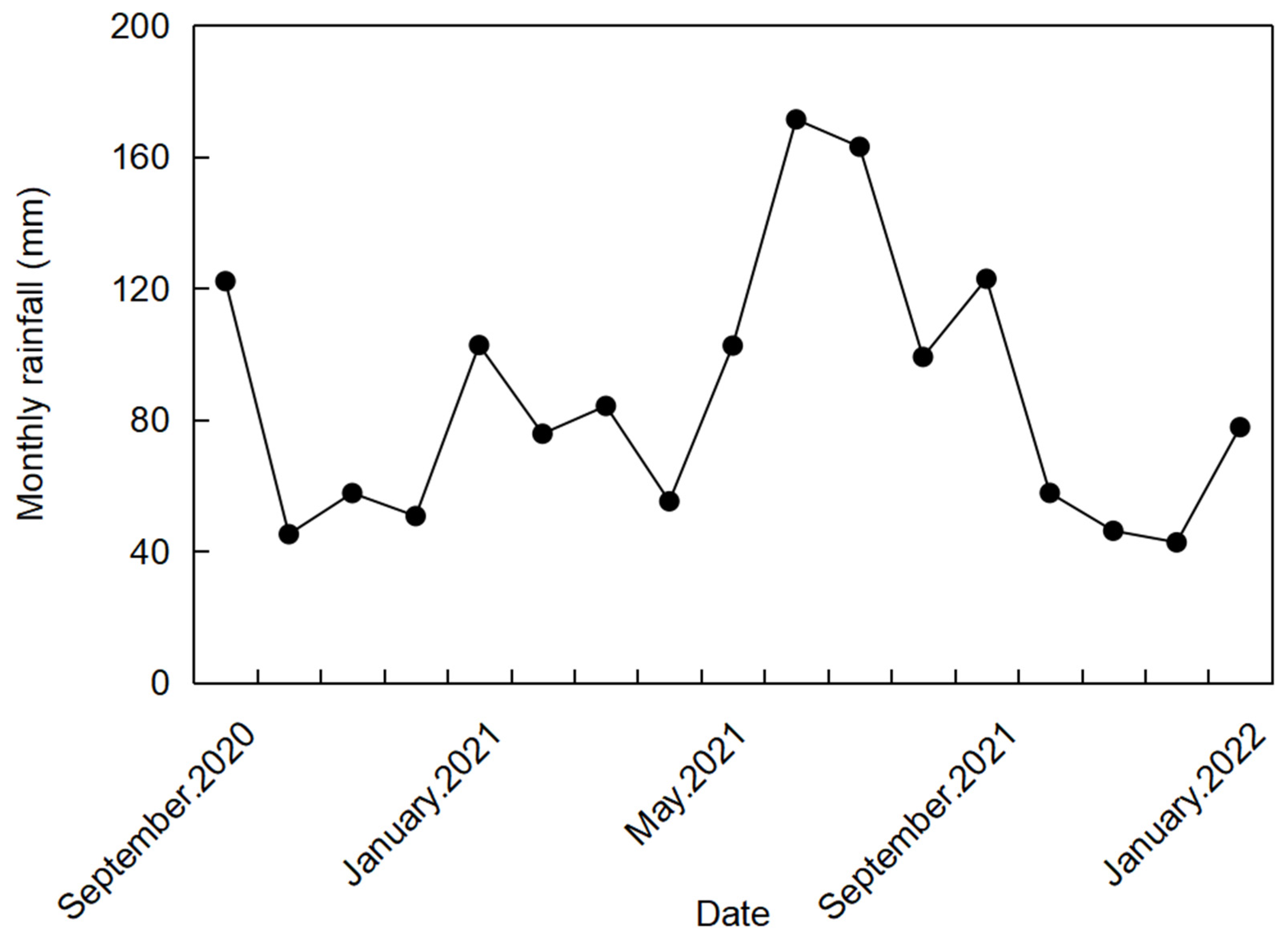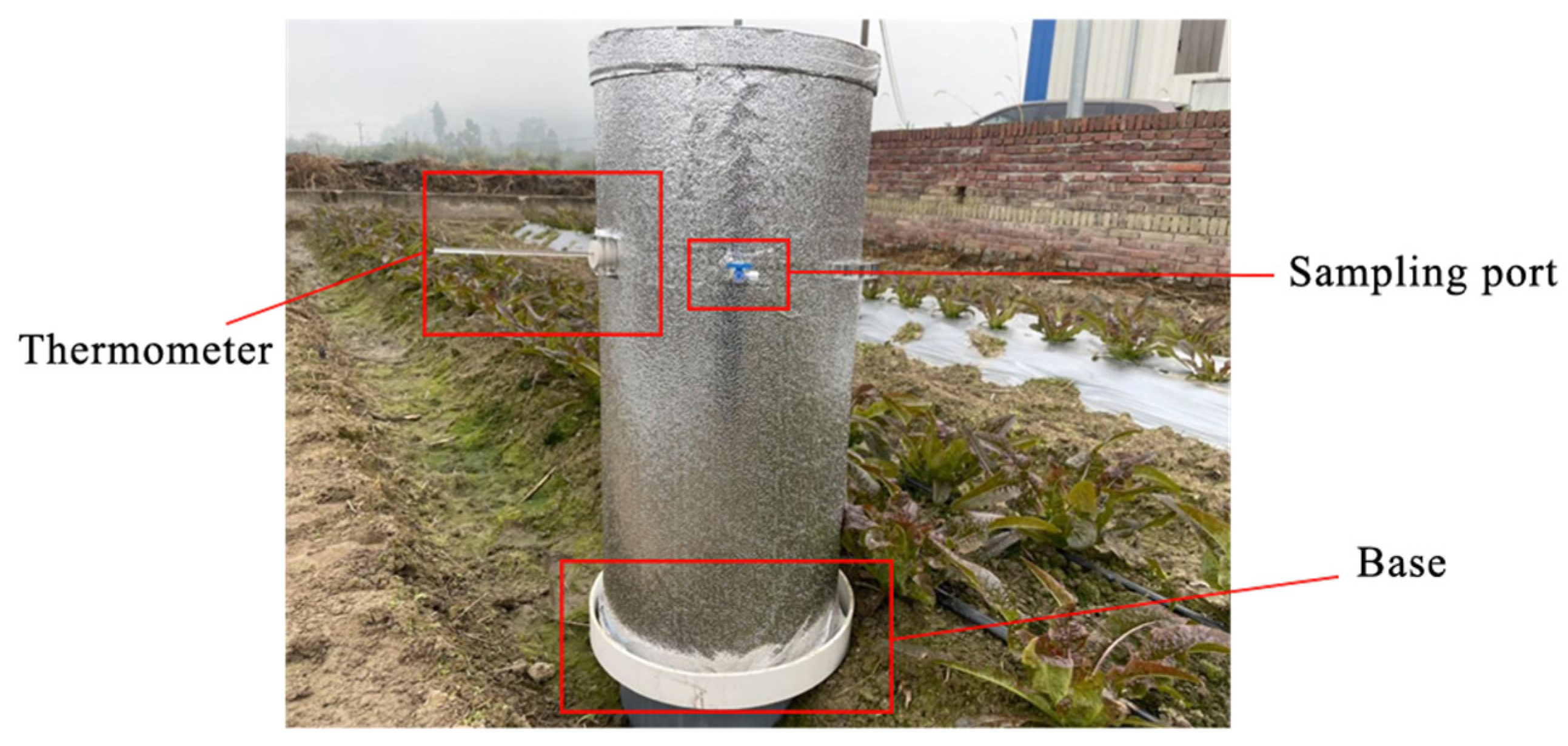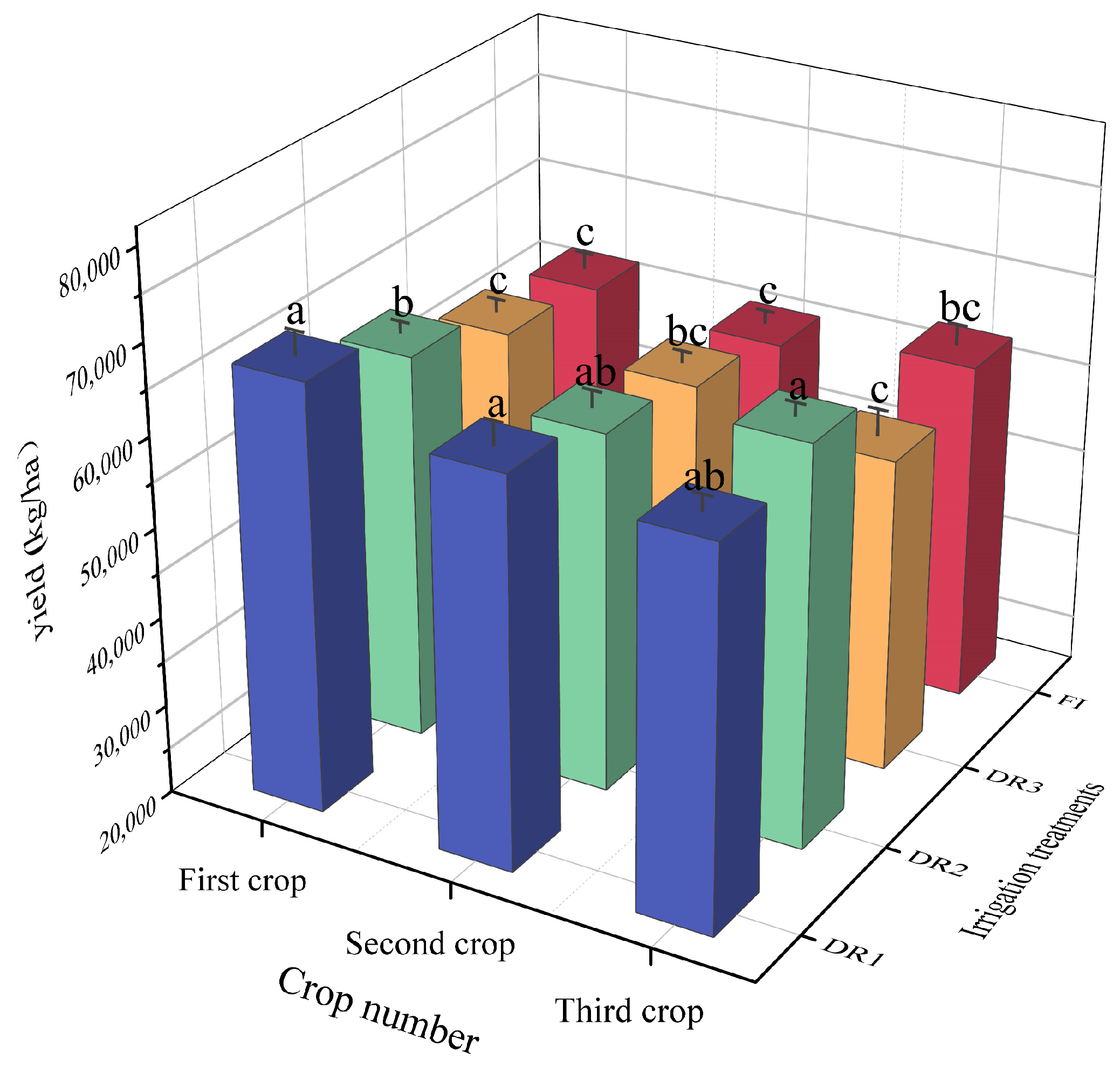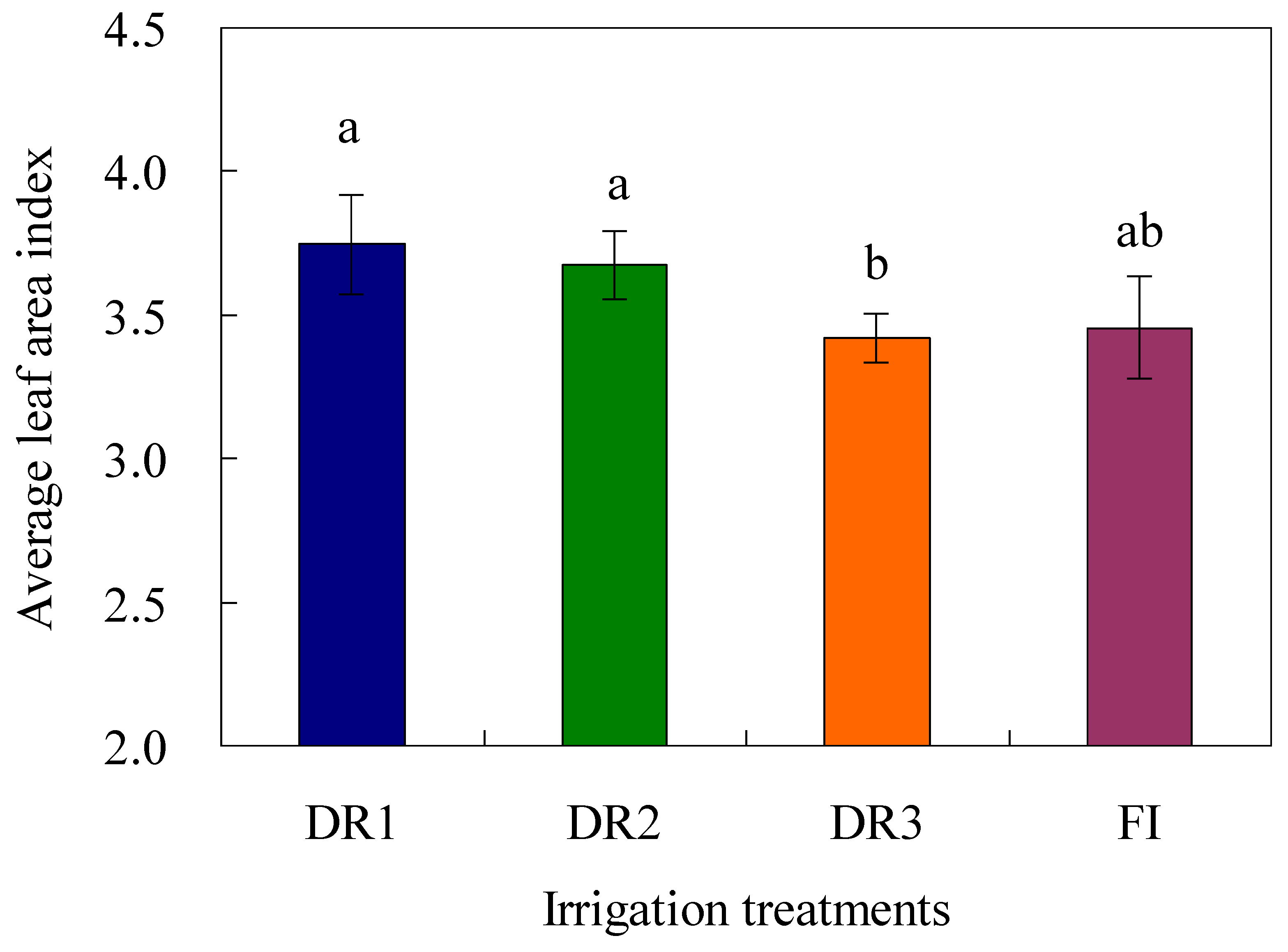Optimization of a Lower Irrigation Limit for Lettuce Based on Comprehensive Evaluation: A Field Experiment
Abstract
1. Introduction
2. Materials and Methods
2.1. Experimental Site
2.2. Cropping Practices, Experimental Design, and Treatments
2.3. Plant Sampling and Measurements
2.4. Measurements and Determination of C and N Emission Fluxes
2.5. Application of the Entropy Weight Coefficient Model
2.6. Statistical Analysis
3. Results and Analysis
3.1. Effect of the Different Irrigation Treatments on the Lettuce Yield
3.2. Effect of the Different Irrigation Treatments on Lettuce LAI
3.3. Effect of the Different Irrigation Treatments on the Quality of Lettuce
3.4. Effect of the Different Irrigation Treatments on the Cracking Rate of Lettuce
3.5. Optimization of Irrigation Systems Based on Water Conservation and Emission Reduction
4. Discussion
5. Conclusions
Author Contributions
Funding
Institutional Review Board Statement
Informed Consent Statement
Data Availability Statement
Conflicts of Interest
References
- Hamad, A.A.A.; Ni, L.; Shaghaleh, H.; Elsadek, E.; Hamoud, Y.A. Effect of Carbon Content in Wheat Straw Biochar on N2O and CO2 Emissions and Pakchoi Productivity Under Different Soil Moisture Conditions. Sustainability 2023, 15, 5100. [Google Scholar] [CrossRef]
- Abalos, D.; Sanchez-Martin, L.; Garcia-Torres, L.; van Groenigen, J.W.; Vallejo, A. Management of irrigation frequency and nitrogen fertilization to mitigate GHG and NO emissions from drip-fertigated crops. Sci. Total Environ. 2014, 490, 880–888. [Google Scholar] [CrossRef] [PubMed]
- Guo, S.; Qi, Y.; Luo, X. Effects of drip irrigation on soil CO2 and N2O emissions and their global warming potentials of spring wheat field in arid region. J. Agro Environ. Sci. 2016, 35, 792–800. [Google Scholar]
- Hamad, A.A.A.; Wei, Q.; Wan, L.; Xu, J.; Hamoud, Y.A.; Li, Y.; Shaghaleh, H. Subsurface Drip Irrigation with Emitters Placed at Suitable Depth Can Mitigate N2O Emissions and Enhance Chinese Cabbage Yield under Greenhouse Cultivation. Agronomy 2022, 12, 745. [Google Scholar] [CrossRef]
- Ye, X.H.; Han, B.; Li, W.; Zhang, X.C.; Zhang, Y.L.; Lin, X.G.; Zou, H.T. Effects of different irrigation methods on nitrous oxide emissions and ammonia oxidizers microorganisms in greenhouse tomato fields. Agric. Water Manag. 2018, 203, 115–123. [Google Scholar] [CrossRef]
- Yu, Y.; Jiao, Y.; Yang, W.; Song, C.; Zhang, J.; Liu, Y. Mechanisms underlying nitrous oxide emissions and nitrogen leaching from potato fields under drip irrigation and furrow irrigation. Agric. Water Manag. 2022, 260, 107270. [Google Scholar] [CrossRef]
- Gultekin, R.; Avağ, K.; Görgişen, C.; Öztürk, Ö.; Yeter, T.; Alsan, P.B. Effect of deficit irrigation practices on greenhouse gas emissions in drip irrigation. Sci. Hortic. 2023, 310, 111757. [Google Scholar] [CrossRef]
- Chen, H.; Shang, Z. Effects of irrigation amounts on soil CO2, N2O and CH4 emissions in greenhouse tomato field. Chin. J. Appl. Ecol. 2019, 30, 102–111. [Google Scholar]
- Yavuz, D.; Seymen, M.; Kal, Ü.; Atakul, Z.; Tanrıverdi, Ö.B.; Türkmen, Ö.; Yavuz, N. Agronomic and physio-biochemical responses of lettuce to exogenous sodium nitroprusside (SNP) applied under different irrigation regimes. Agric. Water Manag. 2023, 277, 108127. [Google Scholar] [CrossRef]
- Zhong, F.; Lin, Y. Research and Innovation on Optimal Utilization of Agricultural Water and Land Resources. China Resour. Compr. Util. 2022, 40, 108–110. [Google Scholar]
- Hamad, A.A.A.; Wei, Q.; Xu, J.; Hamoud, Y.A.; He, M.; Shaghaleh, H.; Wei, Q.; Li, X.; Qi, Z. Managing Fertigation Frequency and Level to Mitigate N2O and CO2 Emissions and NH3 Volatilization from Subsurface Drip-Fertigated Field in a Greenhouse. Agronomy 2022, 12, 1414. [Google Scholar] [CrossRef]
- Kolkiewicz, A.; Rice, G.; Xie, Y. Projection pursuit based tests of normality with functional data. J. Stat. Plan. Inference 2021, 211, 326–339. [Google Scholar] [CrossRef]
- Jin, Q.; You, J.; Xie, M.; Qiu, Y.; Lei, S.; Ding, Q.; Chen, J. Drip Irrigation Reduced Fertilizer Nitrogen Loss from Lettuce Field A Case Study Based on N-15 Tracing Technique. Water 2022, 14, 675. [Google Scholar] [CrossRef]
- Monteith, J.L. Light distribution and photosynthesis in field crops. Ann. Bot. 1965, 29, 17–37. [Google Scholar] [CrossRef]
- Chen, Z. Effects of Different Phosphorus Fertilizers on Growth and Quality of Chinese Cabbage and Lettuce. Mod. Agric. Technol. 2023, 9, 49–57. [Google Scholar]
- Shao, Y.; Chen, J.; Wang, L.; Hou, M.; Chen, D. Effects of fermented organic fertilizer application on soil N2O emission under the vegetable rotation in polyhouse. Environ. Res. 2021, 200, 111491. [Google Scholar] [CrossRef] [PubMed]
- Shao, G. Entropy weight coefficient evaluation of irrigation and drainage scheme based on analysis of quality and rain ingredients of tomat. J. Drain. Irrig. Mach. Eng. 2012, 30, 733–736. [Google Scholar]
- Talpur, M.M.A.; Shaghaleh, H.; Ali Adam Hamad, A.; Chang, T.; Zia-ur-Rehman, M.; Usman, M.; Alhaj Hamoud, Y. Effect of Planting Geometry on Growth, Water Productivity, and Fruit Quality of Tomatoes under Different Soil Moisture Regimes. Sustainability 2023, 15, 9526. [Google Scholar] [CrossRef]
- Hamoud, Y.A.; Guo, X.; Wang, Z.; Shaghaleh, H.; Chen, S.; Hassan, A.; Bakour, A. Effects of irrigation regime and soil clay content and their interaction on the biological yield, nitrogen uptake and nitrogen-use efficiency of rice grown in southern China. Agric. Water Manag. 2019, 213, 934–946. [Google Scholar] [CrossRef]
- Hansona, B.R.; Schwankl, L.J.; Schulbach, K.F.; Pettygrove, G.S. A comparison of furrow, surface drip, and subsurface drip irrigation on lettuce yield and applied water. Agric. Water Manag. 1997, 33, 139–157. [Google Scholar] [CrossRef]
- Xiao, B. Analysis of the Effects of Different Irrigation Techniques on Soil Moisture and Cotton Leaf Area Index. Agric. Technol. 2020, 40, 33–35. [Google Scholar]
- Zhou, D. Effects of Different Water and Fertilizers Treatment on Water Use Efficiency and Nutrient Absorption Characteristics of Asparagus Lettuce; Gansu Agricultural University: Lanzhou, China, 2014. [Google Scholar]
- Jian, Z.; Huanjie, C. Effect of water-controlled partial wetting irrigation on the growth and water use efficiency of leaf lettuce. Agric. Res. Arid. Areas 2008, 6, 70–75. [Google Scholar]
- Wang, S.; Jia, X. Response Mechanism of Crops to Drought Stress and Measures for Improving Drought Resistance of Crops: Research Progress. Chin. Agric. Sci. Bull. 2022, 38, 31–44. [Google Scholar]
- Sharabiani, V.R.; Sabzi, S.; Pourdarbani, R.; Solis-Carmona, E.; Hernández-Hernández, M.; Hernández-Hernández, J.L. Non-Destructive Prediction of Titratable Acidity and Taste Index Properties of Gala Apple Using Combination of Different Hybrids ANN and PLSR-Model Based Spectral Data. Plants 2020, 9, 1718. [Google Scholar] [CrossRef]
- Nektarios, P.A.; Ischyropoulos, D.; Kalozoumis, P.; Savvas, D.; Yfantopoulos, D.; Ntoulas, N.; Tsaniklidis, G.; Goumenaki, E. Impact of substrate depth and fertilizer type on growth, production, quality characteristics and heavy metal contamination of tomato and lettuce grown on urban green roofs. Sci. Hortic. 2022, 305, 111318. [Google Scholar] [CrossRef]
- Lan, S. Discussion on pollution-free cultivation techniques for winter and spring lettuce. Agric. Technol. 2019, 39, 115–116. [Google Scholar]
- Sun, S.; Gu, C. Causes and preventive measures of lettuce stem cracking. Hebei Agric. 2015, 2, 27–28. [Google Scholar]
- Hu, Y.M.; Yang, S.Q.; Qian, X.; Li, Z.X.; Fan, Y.C.; Manevski, K.; Chen, Y.; Gao, W. Bibliometric Network Analysis of Crop Yield Gap Research over the Past Three Decades. Agriculture 2023, 13, 2105. [Google Scholar] [CrossRef]
- Bossolani, J.W.; Meneghette, H.H.A.; Sanches, I.R.; Dos Santos, F.L.; Parra, L.F.; Lazarini, E. 5-year Effects of Potassium Fertilization Levels on Nutrition Balance and Yield in the Maize/Soybean Succession. Commun. Soil Sci. Plant Anal. 2022, 53, 2017–2028. [Google Scholar] [CrossRef]
- Jiang, Z.H.; Zhong, Y.M.; Yang, J.P.; Wu, Y.X.Y.; Li, H.; Zheng, L. Effect of nitrogen fertilizer rates on carbon footprint and ecosystem service of carbon sequestration in rice production. Sci. Total Environ. 2019, 670, 210–217. [Google Scholar] [CrossRef] [PubMed]
- Duan, Y.; Mu, H.; Li, N.; Li, L.; Xue, Z. Research on Comprehensive Evaluation of Low Carbon Economy Development Level Based on AHP-Entropy Method: A Case Study of Dalian. Energy Procedia 2016, 104, 468–474. [Google Scholar] [CrossRef]







| Season Order | Date | Growth Stages | Watering Periods | Mean Temperate (°C) |
|---|---|---|---|---|
| First season | 15 September 2020–17 September 2020 | Seed germination | 29.87 | |
| 18 September 2020–12 October 2020 | Seedling stage | 26.56 | ||
| 13 October 2020–16 November 2020 | Rosette stage | ☆ | 23.82 | |
| 17 November 2020–26 December 2020 | Fleshy stem expansion stage | ☆ | 19.55 | |
| 27 December 2020–30 December 2020 | Harvest stage | 16.75 | ||
| Second season | 16 January 2021–18 January 2021 | Seed germination | 14.01 | |
| 19 January 2021–17 February 2021 | Seedling stage | 18.16 | ||
| 18 February 2021–28 March 2021 | Rosette stage | ☆ | 19.43 | |
| 29 March 2021–8 May 2021 | Fleshy stem expansion stage | ☆ | 23.04 | |
| 9 May 2021–13 May 2021 | Harvest stage | 28.78 | ||
| Third season | 20 September 2021–22 September 2021 | Seed germination | 30.66 | |
| 23 September 2021–15 October 2021 | Seedling stage | 29.43 | ||
| 16 October 2021–21 November 2021 | Rosette stage | ☆ | 22.59 | |
| 22 November 2021–2 January 2022 | Fleshy stem expansion stage | ☆ | 19.11 | |
| 3 January 2022–6 January 2022 | Harvest stage | 16.25 |
| Season Order | Treatments | The Stage from Rosette to Fleshy Stem Expansion | Total Water Use (mm) | |||
|---|---|---|---|---|---|---|
| Irrigation Times | Irrigation Interval (d) | Irrigation Quota (mm) | Irrigation Amount (mm) | |||
| First season | DR1 | 8 | 8.7 | 15.8 | 126.5 | 299.1 |
| DR2 | 5 | 14.0 | 23.7 | 118.6 | 291.2 | |
| DR3 | 3 | 23.5 | 31.6 | 94.9 | 267.5 | |
| FI | 5 | 14.0 | 23.7 | 118.6 | 291.2 | |
| Second season | DR1 | 7 | 11.1 | 15.8 | 110.6 | 275.7 |
| DR2 | 4 | 19.5 | 23.7 | 94.8 | 259.9 | |
| DR3 | 2 | 39.0 | 31.6 | 63.2 | 228.3 | |
| FI | 4 | 19.5 | 23.7 | 94.8 | 259.9 | |
| Third season | DR1 | 8 | 9.5 | 15.8 | 126.5 | 284.1 |
| DR2 | 5 | 15.2 | 23.7 | 118.6 | 276.2 | |
| DR3 | 3 | 25.3 | 31.6 | 94.9 | 252.5 | |
| FI | 5 | 15.2 | 23.7 | 118.6 | 276.2 | |
| Season Order | Treatment Applied | Crude Fiber (%) | Soluble Sugar (%) | Nitrate (mg/kg) | Vitamin c (mg/kg) |
|---|---|---|---|---|---|
| First season | DR1 | 2.67 ± 0.21 b | 4.39 ± 0.12 c | 334.8 ± 9.5 c | 65.2 ± 5.6 b |
| DR2 | 3.22 ± 0.25 a | 4.92 ± 0.08 a | 362.8 ± 13.2 b | 83.6 ± 6.7 a | |
| DR3 | 3.56 ± 0.32 a | 5.08 ± 0.15 a | 412.8 ± 21.8 a | 84.8 ± 6.8 a | |
| FI | 3.11 ± 0.13 a | 4.66 ± 0.09 b | 388.4 ± 24.2 ab | 64.1 ± 5.4 b | |
| Second season | DR1 | 2.78 ± 0.25 c | 4.60 ± 0.15 b | 419.1 ± 21.6 b | 75.1 ± 4.2 b |
| DR2 | 3.81 ± 0.32 ab | 5.35 ± 0.35 a | 422.7 ± 19.1 b | 93.7 ± 7.1 a | |
| DR3 | 3.92 ± 0.11 a | 5.02 ± 0.18 a | 481.8 ± 29.7 a | 87.6 ± 4.2 a | |
| FI | 3.71 ± 0.06 b | 4.45 ± 0.19 b | 440.7 ± 31.5 ab | 77.1 ± 2.9 b | |
| Third season | DR1 | 3.22 ± 0.15 c | 4.63 ± 0.15 b | 392.6 ± 19.2 c | 73.3 ± 3.9 c |
| DR2 | 3.62 ± 0.08 b | 4.61 ± 0.19 b | 412.3 ± 25.6 bc | 85.7 ± 2.5 b | |
| DR3 | 3.86 ± 0.11 a | 5.26 ± 0.36 a | 482.7 ± 18.3 a | 92.3 ± 1.5 a | |
| FI | 3.77 ± 0.15 ab | 4.72 ± 0.29 ab | 434.6 ± 15.8 b | 67.5 ± 4.8 c |
| Treatment | Yield (kg/ha) | Stem Cracking Rate (%) | Nitrogen Use Efficiency (%) | Irrigation Water Use Efficiency (kg/m3) | Crude Fiber (%) | Soluble Sugar (%) | Nitrate (mg/kg) | Vc (mg/kg) | C Emission (g C/m2) | N Emission (kg/ha) |
|---|---|---|---|---|---|---|---|---|---|---|
| DR1 | 64,500 | 16.7 | 41.6 | 22.52 | 2.89 | 4.54 | 382.16 | 71.21 | 344.7 | 2.10 |
| DR2 | 62,700 | 10.9 | 41.5 | 22.73 | 3.55 | 4.96 | 399.26 | 87.68 | 459.6 | 2.41 |
| DR3 | 57,360 | 17.2 | 37.3 | 22.98 | 3.78 | 5.12 | 459.12 | 88.23 | 483.4 | 2.99 |
| FI | 57,060 | 24.2 | 34.7 | 20.68 | 3.53 | 4.61 | 421.23 | 69.58 | 382.7 | 3.95 |
Disclaimer/Publisher’s Note: The statements, opinions and data contained in all publications are solely those of the individual author(s) and contributor(s) and not of MDPI and/or the editor(s). MDPI and/or the editor(s) disclaim responsibility for any injury to people or property resulting from any ideas, methods, instructions or products referred to in the content. |
© 2024 by the authors. Licensee MDPI, Basel, Switzerland. This article is an open access article distributed under the terms and conditions of the Creative Commons Attribution (CC BY) license (https://creativecommons.org/licenses/by/4.0/).
Share and Cite
Hou, M.; Zhang, H.; Shaghaleh, H.; Chen, J.; Zhong, F.; Alhaj Hamoud, Y.; Zhu, L. Optimization of a Lower Irrigation Limit for Lettuce Based on Comprehensive Evaluation: A Field Experiment. Plants 2024, 13, 853. https://doi.org/10.3390/plants13060853
Hou M, Zhang H, Shaghaleh H, Chen J, Zhong F, Alhaj Hamoud Y, Zhu L. Optimization of a Lower Irrigation Limit for Lettuce Based on Comprehensive Evaluation: A Field Experiment. Plants. 2024; 13(6):853. https://doi.org/10.3390/plants13060853
Chicago/Turabian StyleHou, Maomao, Houdong Zhang, Hiba Shaghaleh, Jingnan Chen, Fenglin Zhong, Yousef Alhaj Hamoud, and Lin Zhu. 2024. "Optimization of a Lower Irrigation Limit for Lettuce Based on Comprehensive Evaluation: A Field Experiment" Plants 13, no. 6: 853. https://doi.org/10.3390/plants13060853
APA StyleHou, M., Zhang, H., Shaghaleh, H., Chen, J., Zhong, F., Alhaj Hamoud, Y., & Zhu, L. (2024). Optimization of a Lower Irrigation Limit for Lettuce Based on Comprehensive Evaluation: A Field Experiment. Plants, 13(6), 853. https://doi.org/10.3390/plants13060853










